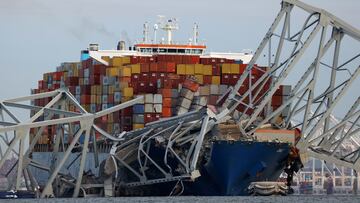BALTIMORE BRIDGE
Why did the Baltimore bridge collapse? Ship hit “critical point of support”
The Francis Scott Key Bridge in Baltimore, Maryland, collapsed early on Tuesday after being hit by a container ship headed for Sri Lanka.

Baltimore is dealing with what officials are describing as a “mass casualty event” after the Francis Scott Key Bridge collapsed in the early hours of Tuesday morning, having been hit by a container ship.
Search and rescue operation after bridge collapse
“There were likely multiple people on the bridge at the time of the collapse,” Baltimore City Fire Department Chief James Wallace has told a news conference, revealing that a search and rescue operation is looking for at least seven people.
Given the low temperatures of the water in Baltimore Harbor - they were around 45 degrees Fahrenheit at the time of the collapse - there are fears over how long victims can survive in the Patapsco River, with the possibility of hypothermia a major concern. Speaking to reporters, Wallace added that two individuals have already been pulled from the water. While one was uninjured, he said the other was hospitalised in a “very serious condition”.
The accident occurred at 1:30am local time on Tuesday, when the Singapore-flagged ship the Dali collided with one of the support columns underneath the 1.6-mile-long bridge, which runs across the Patapsco River and is the outermost of three toll crossings of the harbor. Vehicles were on the bridge when the collision happened, sending them into the water.
See also:
“Every column one of bridge’s critical points of support”
Opened in 1977, the Francis Scott Key Bridge is crossed by around 11.5 million vehicles a year, and is part of the Interstate 695, a beltway that runs around Baltimore. Initially known as the Outer Harbor Crossing, it is a steel arch continuous truss bridge that was built with a load-bearing superstructure, but whose key support came from a series of columns.
“Every column is one of the bridge’s critical points of support,” the Spanish radio station Cadena SER was told by Antonio Martínez, a representative of Spain’s Society of Road, Canal and Bridge Engineers. “If the point of support fails, you’re pretty much looking at an inevitable outcome: partial or total collapse.”
Martínez added that the Dali, which was travelling from Baltimore to Colombo, Sri Lanka, hit a chief support column. The point of impact was “the worst place that this could happen”, he said, adding: “When a bridge is designed, you look at the probability of things like this happening […]. This is the most critical situation that the engineers who designed this bridge will have worked on.”
Martínez additionally noted that the size and weight of the container ship may also have been a factor in the bridge’s collapse. The 948-foot-long Dali’s momentum “must have caused a brutal force of impact”, he said.
Video - Baltimore bridge collapses after ship collision:

Design “mismatch” may be key factor
In an interview with Northeastern Global News, Jerome Hajjar, a professor of civil and environmental engineering at Northeastern University, explained that container ships have significantly grown in size since the Francis Scott Key Bridge was built nearly a century ago, potentially leading to a crucial shortfall in the amount of force that the structure was designed to withstand.
“The mismatch between the size of the load and the expected loads at the time of the bridge design could be an important link,” he said.





